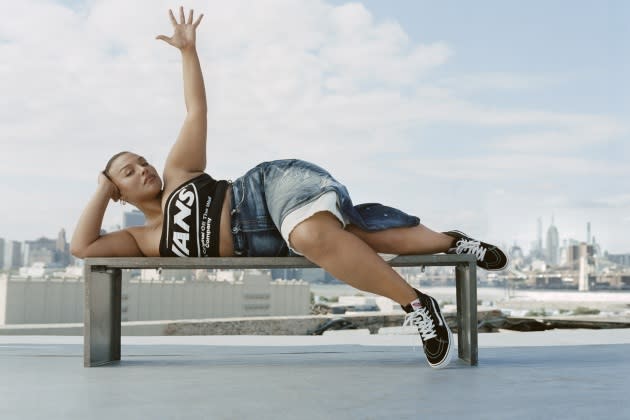Getting Vans Back Into Growth Mode for VF Corp.

Vans is as off the wall as ever — but it’s also a little up in the air right now.
After years of being a growth powerhouse for parent company VF Corp., becoming the firm’s largest and most profitable business, the skate and lifestyle brand has become a source of concern, both at the company and on Wall Street.
More from WWD
Revenues for the fiscal first half ended Oct. 1 fell 10 percent to $1.9 billion, a 6 percent decline in constant currencies. For a brand that grew from about $300 million VF acquired it in 2004 to more than $4.1 billion last year, that’s a problem.
It seems to have been a big enough problem to help push president, chairman and chief executive officer Steve Rendle to “retire,” leaving the board searching for a permanent successor to lead the company forward.
That successor will inherit a Vans that’s on the move.
Global chief marketing officer Kristin Harrer, who joined Vans last year from Dollar Shave Club and is part of the team tasked with turning the business around, told WWD in an interview last month that the brand is ready to tap into a new kind of creativity in its customer base.
Harrer said Vans’ core — its DNA — hadn’t been updated in seven to 10 years and how it articulated who its consumer muse was had stayed the same for five years.
That’s at least half a lifetime for a young customer base — and more given the tectonic shifts of the pandemic.
“When I came in, I was like, ‘All right, let’s take a pause,’” said Harrer, who was hired without meeting her colleagues in person and worked the first six months remotely as the world worked through COVID-19. “Let’s gather the strategy teams, the insights digital team and the marketing team, and go back into the marketplace globally, not just in the U.S. but in all the markets that matter to us and figure out where the consumer’s at.”
That was a mission that, while important for any brand, was vital for Vans.
Kevin Bailey, who returned to Vans this year, taking the reins as global brand president and responsibility for the turnaround, singled out the brand’s disconnect from its consumer as a key issue during a September meeting with analysts.
“We, at the brand, failed to adequately monitor and swiftly and effectively adapt to the changes we need to make and the changes that were going on in our environment,” Bailey said. “That’s unacceptable for a youth culture brand. We missed some market and consumer signals, and with our significant growth, we became complacent to the changes we needed to make.”
Vans — which is driven by sneakers and has a small apparel business — became overly reliant on its core canvas classic styles and needed to innovate more, he said.
The brand has long sought to connect with its customers through the notion of creativity, and will continue to do so, but Harrer said the emphasis has changed and that will become more apparent in its marketing.
“Creativity and how consumers think about creativity has shifted,” she said.

Vans’ mission had been to fuel self-expression and the act of creating — whether that be performing on stage or a skateboard or painting or something else.
Harrer said that while that message “speaks deeply to a creative community, it also leaves a lot of people out.”
When Vans went to its customer base it found a new kind of relationship to creativity.
“Instagram’s here to stay,” Harrer said. “There is a certain performative culture that exists that they have to participate in. But the deeper kind of human yearning underneath all of that is they wish they could kind of push that aside and use their own creativity to fuel themselves.”
That has Vans focusing on skate and surf and the rest of its action sport base, yes, but also on personal narratives of self discovery.
“The way that we’re articulating it now is less about the act of creative self-expression and doing something creative and more about going on a journey that leverages creativity to help you discover who you are,” she said.
This kind of deep thinking on creativity is more necessary today with more consumer brands getting in on the game.
“If creativity is a pie, we really had to figure out, ‘What part of that creativity pie does Vans own?’” Harrer said. “Because TikTok now owns a part of it and Apple owns a part of it. And there’s so many brands that…own pieces of it.
“If we define ourselves by creativity, we had to make it a little bit sharper,” she said. “So it is about this idea of going on a journey of self-discovery and that’s where we’re gonna push hard in the future. It’ll be storytelling that’s less about what’d you make and more about who are you. And so really trying to intentionally connect to a broader swath of people.
“Not everybody’s going to be able to innately connect to a painter and somebody who puts something on a canvas,” she said. “But you can connect to someone’s journey, a lot more people can connect to that.”
It’s a plan to go big that is both necessary if the brand is going to charge through the $5 billion mark and key to the company’s future.
VF has The North Face, Supreme, Timberland and other brands as well, but right now, it needs the Vans business to work.
“There’s real concern about the capital structure at this point,” said John Kernan, an analyst at Cowen, who noted the company will likely have to refinance debt coming due next year at much higher interest rates.
“For equity holders that are really in this for the dividend, I think there’s some concern about putting more leverage on the balance sheet,” Kernan said.
A growing Vans would help ease some worries, so the brand is under the microscope.
Kernan said he watches Vans closely, through web traffic and by other means.
“There’s clearly not been a turn in the data,” he said.
To hit its goals, the brand is going to have to keep growing globally while also building its offering.
“Apparel is clearly part of the long-term growth trajectory,” Kernan said. “I think they need it to be able to get to the $6 billion top-line run rate that they’ve spoken about in the past.”
Marketing is just one piece of the puzzle; the brand is also tweaking its operating structure to be better aligned with a bigger business and making other changes.
It’s worth remembering that, while the brand has taken a step back, it also raced ahead for a long time.
“Vans just went through this hyper growth phase and I think the competitive environment just caught up to them, peers caught up to them, they didn’t innovate enough,” Kernan said. “There wasn’t a lot of newness. They hit a fashion trend and they rode it very well at the time.”
Now the brand just has to get back into the groove — and VF’s future CEO, whomever it might be, will be tasked with making sure it gets there.

